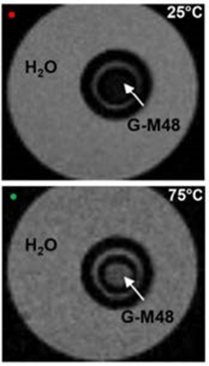Magnetic Nanoparticles for Theranostics
SelfMag® NP are doped ferrite nanoparticles developed by MBN via a proprietary mechano-chemical process, integrating therapy and diagnostics in one platform. With particle sizes of 50–120 nm, they deliver high SAR values (20–30 W/g) and biocompatibility. Their Curie temperature is tunable between 40 and 250 °C, enabling precise thermal control and intrinsic safety in magnetic hyperthermia.
Composition:
Fe₂O₃ balanced with 32–36% MgO, 26–30% TiO₂, and 12–16% stabilizing phases, optimized for controlled heating and magnetic response.
Surface functionalization (glucose, PEG, chitosan) ensures colloidal stability and tailored biodistribution. Validated on MDA-MB-231 cancer cells, SelfMag® NP induce selective necrosis under alternating magnetic fields, with minimal off-target effects.
Beyond hyperthermia, they serve as temperature-sensitive MRI contrast agents and MPI tracers, detecting as few as 3000 labeled cells. Available in water or propan-2-ol dispersions, SelfMag® NP provide a patent-pending, versatile solution for precision nanomedicine.
SelfMag® NP are doped ferrite nanoparticles developed by MBN via a proprietary mechano-chemical process, integrating therapy and diagnostics in one platform. With particle sizes of 50–120 nm, they deliver high SAR values (20–30 W/g) and biocompatibility. Their Curie temperature is tunable between 40 and 250 °C, enabling precise thermal control and intrinsic safety in magnetic hyperthermia.

